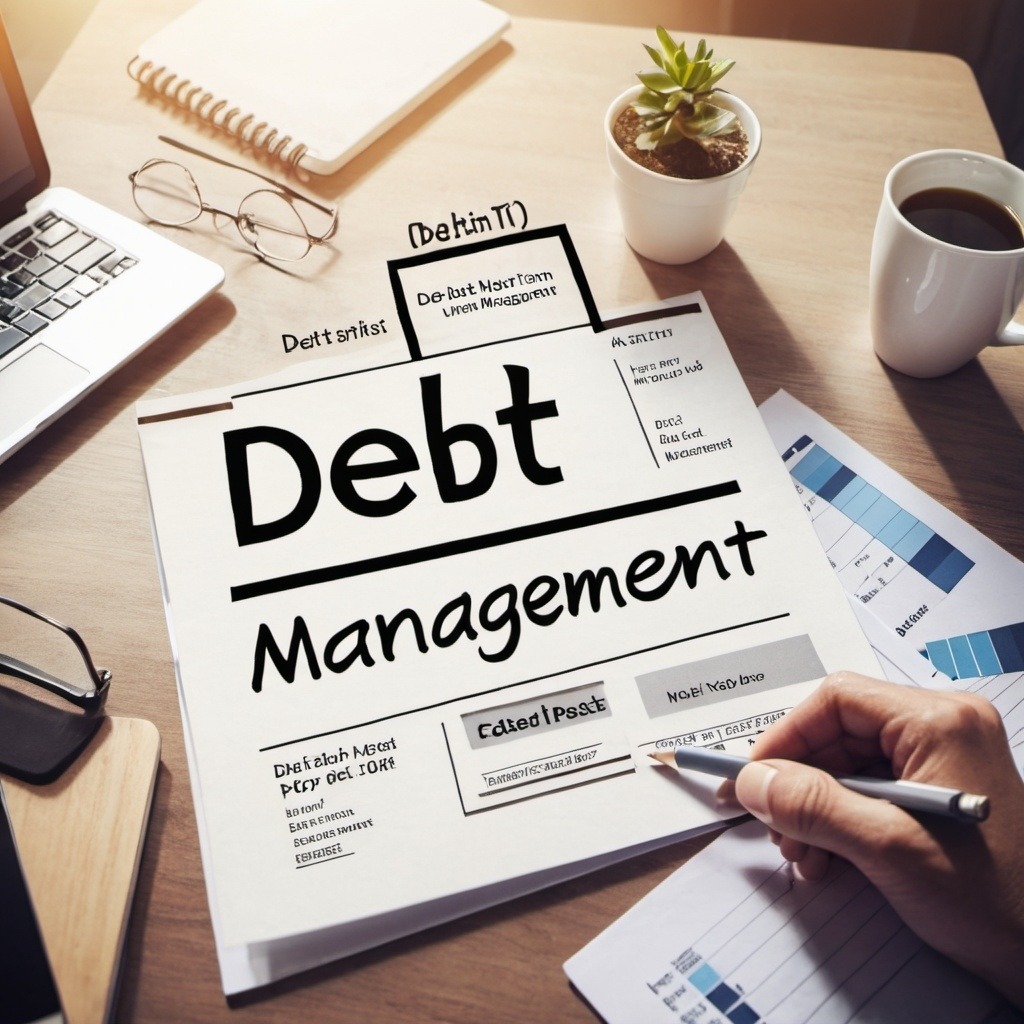
Introduction: Navigating the World of Debt
In today’s fast-paced society, debt has become an almost inevitable part of life. Whether it’s student loans, credit card balances, or mortgages, many of us find ourselves juggling various types of debt. While borrowing can help us achieve our goals, from purchasing a home to pursuing higher education, it also comes with significant responsibilities. Without careful management, debt can quickly spiral out of control, leading to financial stress and long-term repercussions.
Debt management is not just about paying off what you owe—it’s about making informed decisions that protect your financial health now and in the future. Understanding the different types of debt and how to manage them effectively is crucial. From credit counseling services to debt consolidation options, the tools are available to help you navigate this complex landscape. By staying informed and proactive, you can take control of your finances, reduce your debt burden, and work towards a more secure financial future.
Understanding Different Types of Debt
Debt comes in many forms, each with its own set of characteristics and implications. Understanding the differences between them is key to managing your finances effectively.
Secured vs. Unsecured Debt
One of the most fundamental distinctions is between secured and unsecured debt. Secured debt is backed by collateral—something of value that the lender can take if you fail to repay the loan. Common examples include mortgages, where the house is the collateral, and auto loans, where the vehicle itself is at risk. Because these loans are secured by an asset, they often come with lower interest rates.
On the other hand, unsecured debt is not tied to any specific asset. This category includes credit card debt, personal loans, and student loans. Since lenders take on more risk with unsecured debt, interest rates are typically higher. If you fail to make payments, the lender can’t seize your property directly, but they can still pursue legal action, which can damage your credit score and lead to significant financial penalties.
High-Interest vs. Low-Interest Debt
Another important distinction is between high-interest and low-interest debt. High-interest debt, such as credit card balances, can quickly become a financial burden due to the compounding nature of interest. Even small balances can grow rapidly if not paid off in full each month. This type of debt is often considered “bad” debt because it doesn’t usually contribute to building wealth.
In contrast, low-interest debt—such as many mortgages, student loans, or auto loans—can be more manageable. These loans often have fixed rates and predictable payments, making them easier to incorporate into your long-term financial planning. However, even low-interest debt should be managed carefully to avoid unnecessary costs.
Good Debt vs. Bad Debt: Myths and Realities
The concept of “good debt” versus “bad debt” is often oversimplified. Good debt is generally seen as borrowing that helps you acquire assets or increase your income potential, like a mortgage or student loan. These are investments in your future that can provide returns over time. For example, a mortgage can help you build equity in a home, and education can increase your earning power.
Bad debt, by contrast, typically refers to borrowing for depreciating assets or discretionary spending, like credit card purchases for luxury items. This type of debt doesn’t offer a return on investment and can lead to financial strain if not managed properly.
However, it’s important to remember that all debt carries risks, and the line between “good” and “bad” isn’t always clear. For instance, taking on too much “good” debt can still lead to financial trouble if your income changes or you face unexpected expenses. The key is to understand the purpose of your debt and manage it wisely, using resources like debt management plans and financial counseling to keep your finances on track.
The Consequences of Poor Debt Management
Managing debt effectively is crucial for maintaining financial stability. When debt is not managed properly, the consequences can be severe, affecting not only your finances but also your overall well-being.
How Debt Spirals Out of Control
Debt can quickly spiral out of control if not managed carefully. This often begins with small balances on credit cards or missed payments on loans. Over time, the accumulation of interest, late fees, and penalties can cause the debt to grow exponentially. For example, high-interest credit cards can trap you in a cycle where you are only able to make minimum payments, resulting in a balance that never seems to decrease. Before long, you may find yourself borrowing more just to keep up with payments, leading to an ever-growing mountain of debt that becomes increasingly difficult to manage.
Impact on Credit Score and Future Borrowing
Poor debt management can have a devastating impact on your credit score. Missed payments, defaults, and high credit utilization can significantly lower your score, making it harder to borrow money in the future. A lower credit score often means higher interest rates on loans and credit cards, which can further exacerbate financial problems. In some cases, it can even affect your ability to rent an apartment, secure a job, or get approved for a mortgage. The long-term implications of a poor credit score can limit your financial options and make it more challenging to achieve your financial goals.
Emotional and Mental Toll of Unmanaged Debt
The emotional and mental toll of unmanaged debt is often overlooked but can be just as damaging as the financial consequences. Living with overwhelming debt can lead to constant stress, anxiety, and feelings of helplessness. The pressure to meet payment deadlines, coupled with the fear of financial ruin, can take a significant toll on your mental health. This stress can affect your relationships, work performance, and overall quality of life. In extreme cases, unmanaged debt can lead to severe mental health issues such as depression or anxiety disorders.
Essential Strategies for Effective Debt Management
Effective debt management is about more than just making payments—it’s about developing a strategic approach to handling your financial obligations. Here are some essential strategies to help you manage your debt effectively and work towards financial freedom.
Creating a Budget That Works
The foundation of any successful debt management plan is a well-structured budget. A budget helps you track your income and expenses, ensuring that you have enough funds to cover your necessary living costs while also making progress on paying down your debt. Start by listing all your sources of income and then categorize your expenses—such as housing, utilities, food, and transportation—along with your debt payments.
Be realistic about your spending and look for areas where you can cut back to free up more money for debt repayment. By sticking to your budget, you can avoid accumulating additional debt and make steady progress toward becoming debt-free. Tools like budgeting apps and financial spreadsheets can help you maintain discipline and stay on track with your debt management plan.
The Snowball vs. Avalanche Method: Choosing Your Repayment Strategy
When it comes to repaying debt, two popular strategies are the snowball method and the avalanche method. Both approaches have their merits, and the best choice depends on your financial situation and personal preferences.
- The Snowball Method: This strategy involves paying off your smallest debt balances first while making minimum payments on your other debts. Once the smallest debt is paid off, you move on to the next smallest, and so on. The idea is that the quick wins from paying off smaller debts will motivate you to keep going. This method is particularly effective for those who need a psychological boost to stay motivated on their debt management journey.
- The Avalanche Method: With the avalanche method, you focus on paying off the debt with the highest interest rate first while making minimum payments on your other debts. Once the highest-interest debt is paid off, you move on to the next highest. This approach can save you more money in the long run since you’ll pay less in interest over time. The avalanche method is ideal for those who want to minimize the total amount they pay on their debt.
Both strategies can be part of a successful debt management program, and choosing the one that aligns with your goals can make a significant difference in your financial progress.
Consolidating Debt: Pros and Cons

Debt consolidation is another effective strategy that can simplify your finances and potentially reduce your interest costs. This approach involves combining multiple debts into a single loan, often with a lower interest rate. By consolidating your debts, you can streamline your monthly payments into one payment, making it easier to manage your finances.
- Pros of Debt Consolidation:
- Simplifies your debt management by reducing the number of payments you need to track.
- Can lower your overall interest rate, saving you money over time.
- May reduce your monthly payments, making your debt more manageable.
- Cons of Debt Consolidation:
- You may end up paying more in total interest if you extend the loan term.
- Consolidation loans often require good credit, which may not be an option if your credit score has suffered due to unpaid debts.
- It doesn’t address the underlying habits that led to debt accumulation, so it’s important to also focus on developing better financial practices.
Before opting for debt consolidation, consider whether it’s the best choice for your situation. If you’re unsure, consulting a financial advisor or enrolling in a debt management program can help you weigh the pros and cons based on your specific needs. By choosing the right strategy, you can take control of your debt and work toward a more secure financial future.
Tools and Resources for Debt Management
Effectively managing debt often requires utilizing the right tools and seeking expert guidance. From debt management apps to financial counseling services, there are numerous resources available to help you take control of your finances.
Debt Management Apps and Online Tools
In today’s digital age, managing your finances has never been easier, thanks to a variety of debt management apps and online tools. These resources can help you track your spending, set up a debt management plan, and monitor your progress toward becoming debt-free.
- Budgeting Apps: Apps like Mint or YNAB (You Need A Budget) allow you to create a personalized budget, track your expenses, and set financial goals. These apps can also send you alerts when you’re approaching your budget limits, helping you stay on track with your debt payments.
- Debt Payoff Calculators: Online tools like debt payoff calculators can show you how long it will take to pay off your debt based on your current payments and interest rate. These calculators can also help you compare different repayment strategies, such as the snowball or avalanche methods.
- Credit Monitoring Services: Monitoring your credit score is crucial when managing debt. Services like Credit Karma provide free access to your credit score and report, helping you track improvements as you pay down debt and identify any potential issues early on.
Using these tools as part of a comprehensive debt management program can help you stay organized, make informed decisions, and see tangible progress in reducing your debt.
Financial Counseling Services: When and How to Seek Help

If your debt feels overwhelming, seeking professional help through financial counseling services can be a game-changer. Certified financial counselors can provide personalized advice, help you develop a realistic debt management plan, and negotiate with creditors on your behalf.
- When to Seek Help: If you’re struggling to make monthly payments, constantly relying on credit cards to cover basic expenses, or feeling anxious about your financial situation, it might be time to consult a financial counselor. They can assess your overall financial health, help you prioritize debts, and explore options you may not have considered.
- How Financial Counseling Works: A financial counselor will work with you to create a detailed budget, evaluate your debts, and develop a strategy for paying them off. They can also assist you in setting up a formal debt management program, where you make a single payment each month that is distributed among your creditors, often at a reduced interest rate.
Seeking help from a financial counselor can provide you with the knowledge and support needed to regain control of your finances and reduce your debt burden.
Understanding Debt Relief Options: Settlements, Bankruptcy, and More
For some individuals, traditional debt repayment strategies may not be enough to resolve their financial difficulties. In such cases, understanding the available debt relief options is crucial.
- Debt Settlements: Debt settlement involves negotiating with creditors to reduce the total amount you owe in exchange for a lump-sum payment. While this can be an effective way to resolve debt for less than the full balance, it can also negatively impact your credit score and may have tax implications. It’s essential to weigh these factors before pursuing this option.
- Bankruptcy: Bankruptcy is often considered a last resort, but it can provide a fresh start for those facing insurmountable debt. There are different types of bankruptcy, such as Chapter 7 and Chapter 13, each with its own requirements and consequences. While bankruptcy can discharge most of your debts, it also has a severe and lasting impact on your credit score, making it difficult to obtain credit in the future.
- Debt Consolidation Loans: As mentioned earlier, debt consolidation can simplify your finances by combining multiple debts into one loan with a potentially lower interest rate. However, it’s important to consider the loan terms carefully, as extending the repayment period might increase the total amount of interest you pay over time.
Each debt relief option has its pros and cons, and the right choice depends on your specific financial situation. Consulting with a financial counselor or attorney can help you understand the implications of each option and determine the best course of action.
Building a Debt-Free Future
Achieving and maintaining a debt-free future requires more than just paying off existing debts; it involves adopting practices that safeguard your financial health in the long run. Here are some essential steps to ensure you stay on the path to financial freedom.
The Importance of an Emergency Fund
One of the most critical components of a debt-free future is establishing a solid emergency fund. This fund serves as a financial safety net, providing you with the resources to cover unexpected expenses without resorting to credit cards or loans. Whether it’s a sudden medical bill, car repair, or job loss, having three to six months’ worth of living expenses saved in an easily accessible account can prevent you from falling back into debt.
Building an emergency fund should be a top priority as you work toward becoming debt-free. Start by setting aside a small amount from each paycheck, and gradually increase your contributions as you pay off debt. Even a modest emergency fund can provide peace of mind and protect your financial stability in the face of life’s uncertainties.
Investing in Your Financial Education
A key element of long-term financial success is a commitment to continuous learning. Investing in your financial education empowers you to make informed decisions and avoid common pitfalls that can lead to debt. Understanding personal finance topics such as budgeting, investing, retirement planning, and credit management can help you build wealth and secure your financial future.
There are numerous resources available to enhance your financial knowledge, including books, online courses, and workshops. Consider taking a course on personal finance or attending a seminar on smart investing. The more you know, the better equipped you’ll be to make decisions that align with your financial goals and keep you out of debt.
Developing Healthy Spending Habits for Long-Term Success
Finally, developing healthy spending habits is crucial for maintaining a debt-free lifestyle. This involves being mindful of your spending, living within your means, and prioritizing saving over impulsive purchases. Here are some tips to help you cultivate healthy financial habits:
- Track Your Spending: Regularly review your expenses to identify areas where you can cut back. Small changes, such as reducing dining out or canceling unused subscriptions, can add up over time and free up funds for savings or investments.
- Practice Delayed Gratification: Avoid the temptation to make impulse purchases by waiting 24 hours before buying something non-essential. This pause allows you to evaluate whether the purchase aligns with your financial goals.
- Prioritize Saving and Investing: Treat saving and investing as essential expenses, not optional ones. Automate contributions to your savings and retirement accounts to ensure you’re consistently building your financial future.
- Live Below Your Means: Focus on living a lifestyle that reflects your financial reality, not one driven by societal pressures or the desire to keep up with others. This approach helps you avoid unnecessary debt and allows you to allocate more resources toward achieving your financial goals.
